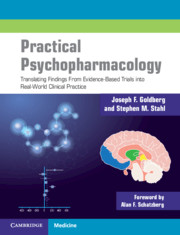 Practical Psychopharmacology
Practical Psychopharmacology from Part I - General Principles
Published online by Cambridge University Press: 19 October 2021
Many patients with complicated psychiatric disorders – which we will define here as conditions involving multiple comorbidities, atypical or protracted symptoms, persistent functional impairment, and poor treatment response – often find themselves taking multidrug therapy regimens. Sometimes, combination therapies reflect wise, thoughtful, and even elegant amalgams crafted with careful deliberation. Such handiwork might capitalize on pharmacodynamic synergies and complementary, nonredundant mechanisms of action, or specific medications may make unique contributions to an overall regimen (such as drugs thought to exert anti-impulsivity, antisuicide, pro-cognitive, or anxiolytic effects). In a well-devised multidrug treatment plan, each component ideally has a well-defined job description and fills a particular role, much the way each player on a sports team covers a unique position, or every instrument in an orchestra makes its own distinct contribution to form a cohesive whole. In that sense, every drug within a psychopharmacology regimen should serve an identifiable and unambiguous function.
To save this book to your Kindle, first ensure [email protected] is added to your Approved Personal Document E-mail List under your Personal Document Settings on the Manage Your Content and Devices page of your Amazon account. Then enter the ‘name’ part of your Kindle email address below. Find out more about saving to your Kindle.
Note you can select to save to either the @free.kindle.com or @kindle.com variations. ‘@free.kindle.com’ emails are free but can only be saved to your device when it is connected to wi-fi. ‘@kindle.com’ emails can be delivered even when you are not connected to wi-fi, but note that service fees apply.
Find out more about the Kindle Personal Document Service.
To save content items to your account, please confirm that you agree to abide by our usage policies. If this is the first time you use this feature, you will be asked to authorise Cambridge Core to connect with your account. Find out more about saving content to Dropbox.
To save content items to your account, please confirm that you agree to abide by our usage policies. If this is the first time you use this feature, you will be asked to authorise Cambridge Core to connect with your account. Find out more about saving content to Google Drive.